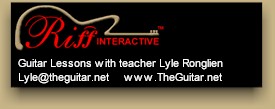Scroll through the lesson and click on notation/video/audio links to load the interactive players.
Please subscribe to get full access to all lessons for only $7.95/month PLUS 1 week free trial.

Riff Interactive lessons are
LESS expensive and
MORE interactive than alternatives!
More Info
|
|

Jam Sessions - Rock
Style II
Lesson 8 - Jam in C# continued
Lyle:
The jam track in the last lesson was so much fun for me I thought I'd use it
again for this lesson. I'd like to show you a couple ideas you can play against
it using modes. First load up your jam track:
Lyle:
Here's the rhythm riff:
Lyle:
Since there is only a riff consisting of just a C# and a Bb note as the roots,
it leaves it wide open as to what key the jam or riff is centered around. Look
at this next TAB file:
Lyle:
The two notes in question can be found in 3 different major scales. This means
you can play in 3 totally different keys at any time while jamming to this jam
track. This opens up so many tonal possibilities which helps you get out of the
rut one can easily get in when jamming using a pentatonic all the time.
Lyle:
The C# note is the 5th degree in the F# major scale, C# is the 4th degree in the Ab major scale, and it's the 2nd degree in the B major scale.
Lyle:
Even though the C# note is in several other major scales, it's the two notes
here in this riff that are only in these 3 different scales. Through the process
of elimination I worked that out.
srvfan: Cool, so there is many possibilities to where you
could even play pentatonic over?
Lyle:
Yes!
Picky: How
is the chords are C# and Bb when there is a G# and F as the bass notes?
Lyle:
Those are lower 5ths on the guitar, the bass guitar is playing C# to Bb. Your
root notes are on the 5th string in the rhythm riff tab.
Lyle:
The C# mixolydian is the 5th mode in the key of F# major.
Lyle: If
you listen back to that tab file you'll hear how the Mixolydian mode sounds
against the jam track. You'll also see it lay out all across the virtual neck.
Lyle:
Here's the first solo from the lesson sample above. This is made from the C#
Mixolydian mode which is the 5th mode in the key of F# major. You may notice
you'll be playing a F# major scale ascending riff in bar 3:
Lyle: In
that solo you are combining a B mixolydian arpeggio riff with a F# major scale
riff, with a unison bending riff.
Lyle:
The next solo from the lesson sample switches keys to Ab major for what I think
is a very interesting sound. Remember, the two rhythm notes C# and Bb are found
in the Ab major scale. They are the 2nd and 4th degrees in the key of Ab. Listen
to how this scale sounds against the jam track:
Lyle:
Here's a solo I made from this scale:
zz: Can we use
Ab mixolydian as well?
Lyle: Yes, but I don't think I would because it
would only give you the straight major sound against the C# jam
track.
Lyle: Ab mixolydian is the V of C#, meaning you would
be playing notes from the C# major scale. That would give you the opposite of
the blues sound, and Rock style comes from the Blues
style.radica: The Ab
adds some nice tension to the melody.
Lyle: Ab is the 5th of C# so it should sound
"perfect" and not add any tension.
Lyle: But if you wanted to get back to that
rockin' bluesy sound, then fall back into the C# minor pentatonic or even the C#
Dorian minor mode, which is the 2nd mode in the key of B major:
Lyle:
Since the jam can be thought of as the C#m, the 2nd in the key of B major, you
could play a riff using the E Lydian mode, a nice and exotic sound mode.
zz: Seems like
Minor pent and Dorian work on lots of scenarios
Lyle: Many have traveled the world with only the
minor pentatonic.
Lyle: Here's an example and the last solo from
the lesson sample:
radica: what
sort of mode run is that on the end of the E Lydian?
Lyle: That last measure is from notes in E Lydian
/ B major.
Lyle: Here it is down an
octave:
zz: I
think they call that Ala mode
write: Thanks Lyle. You put so much into the
lessons.
radica:
Yep, Thanks for the time as usual Lyle!
zz: Thanks
man...........top notch as always:)
Pete: thank you
Lyle
Lyle:
welcome!
Lyle: That's all for this lesson, have a great
week and hope to see you
again.
|
<< load notation from left
|
|
<< load audio from left
|
<< load audio from left
|